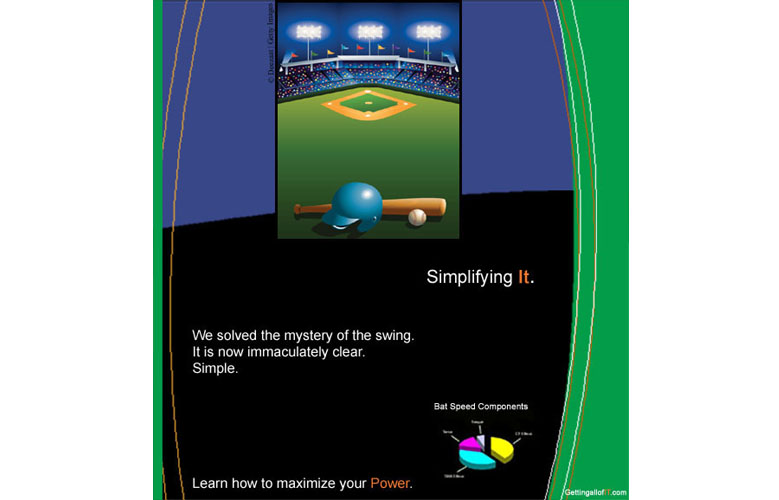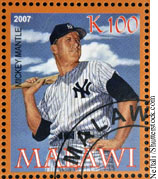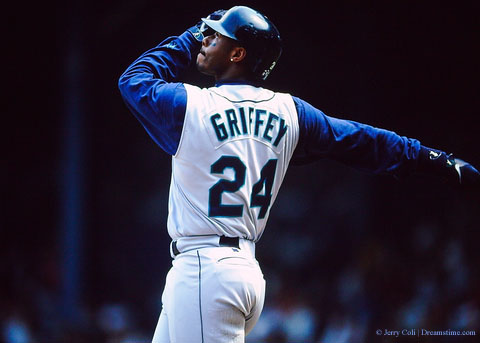Knowledge is Power.

Welcome to Getting All of IT.com
"The Place to Learn How the Baseball Swing Really Works"

Baseball and Softball coaches can breathe a sigh of relief because now, after 120 years of living with fragmented and confusing information, there is FINALLY a place to get the complete and accurate understanding of the swing.
- Brief History of the Baseball Swing -
The amazing baseball swing uses virtually every muscle in your body to get the required bat speed (70 mph) in a remarkably small amount of time - - roughly 0.15 seconds!
 When baseball started 120 years ago, no one had any idea they could swing the bat in that short amount of time - - much less understand what was really going on. In the final chapter in The Science of the Baseball Swing, Babe Ruth and the other home run kings are discussed, and it’s fascinating to witness how the swing progressed over time from their point of view.
When baseball started 120 years ago, no one had any idea they could swing the bat in that short amount of time - - much less understand what was really going on. In the final chapter in The Science of the Baseball Swing, Babe Ruth and the other home run kings are discussed, and it’s fascinating to witness how the swing progressed over time from their point of view.
Unfortunately the (understanding of the) physics has lagged far behind this empirical learning by ballplayers. This is the reason for so many myths, misunderstandings, and strange terms used to explain (and coach) the swing. The ballplayers and coaches have simply done the best they can by inventing terms that help them relate what they’ve learned - - or at least what they think they have learned. They deserve a lot a credit.
When the first physics finally emerged with Robert Adair’s “The Physics of Baseball” in 1990, the baseball swing (unfortunately) got even more confused by the concept that the initial weight-shift (free-fall) somehow contributed to your actual bat speed. Thus began the modern era of confusing “linear” versus rotational hitting arguments. Subsequent models based on the “double pendulum” and “kinetic links” are likewise incorrect or incomplete and simply add to this ongoing confusion.
This book The Science of the Baseball Swing finally, for the first time in 120 years of baseball, presents the correct and complete understanding of the swing.
Simply stated, the baseball swing is the Ice Skater sticking out his arms (he slows down) and then pulling in his arms (he speeds up). It's that "simple". The successful baseball swing employs these two tools to accomplish that amazing bat speed in the 0.15 seconds.
Our job was to create a short (100 page or less) book that relates this simple understanding in a language that coaches and players can easily and quickly absorb - - and use to explain the swing to themselves and others. Mission accomplished.
Here's how those 100 pages are configured (also see Table of Contents)
I. Primary Contents
Six chapters (60 pages) provide all the information you need to fully understand the baseball swing, and how to maximize BOTH your power and your batting average.
- Chapter 5 covers the actual bat speed generation process (your muscles)
- It then nicely summarizes your power in a bottom line fashion, explaining that since your arms are attached to the bat, your arms are what have to ultimately accelerate the bat - - providing your power.
- The other chapters are equally important, and they discuss your alignment (your bones) as your swing progresses. This impacts your power, aiming, and distance.
This book is written for coaches and ballplayers (not physicists or nerds). With that in mind we do provide bottom-line numbers, such as what % of your power comes from each part of your swing; what limits that power; what the forces are; how much power you gain or lose by choking up, pull hitting, etc; These are very useful numbers for coaches and players.
II. The Field Guide:
Chapter 7 is the supplemental Field Guide for both coaches and players. It reveals how a single inexpensive snapshot (above) provides an excellent opportunity for evaluating your swing.
To accomplish this, Chapter 7 provides numerous photos of players in this position, and evalutates them for you.
It also:
- Regurgitates the entire book contents into a Power Summary explaining what’s happening immediately before, during, and after this snapshot.
Thereafter Chapter 7 also provides guidance for
- Weight room training priorities:
- When and where to add muscles - - and, just as important, where not to add more muscle.
- At-the-plate choices:
- Compares the power you gain or loose by choking up vs. hugging the plate, and helps you understand pull-hitting.
III. Home Run Kings
Chapter 8 is the Conclusion.
We cover ten specific professional players and explain their home run hitting (power) personalities - - using the book's language.
This includes Babe Ruth, Ty Cobb, Ted Williams, Roger Maris, Mickey Mantle, Mark McQwire, Ichiro Suzuki, Barry Bonds, Ken Griffey Jr, and Edgar Martinez.
You also learn what each home run king did to outdo the prior one. As explained earlier, this gives you a fascinating history of the learning of the swing.
Finally, we discuss what "Getting All of IT" really means,
and:
- What % of your total muscle power actually ends up in the bat and ball (you'll be surprised),
- That batting average, and not power, is the real goal of your swing,
- Why ballplayers may go into a slump now and then, and
- Why the baseball crowd typically orders more beer for all the wrong reasons.
 |
|---|
| Home | About us | Contact us | | Photo Credits | Guestbook & Comments |Privacy Policy |
©2013 Silvercreek Co Publishing, All Rights Reserved